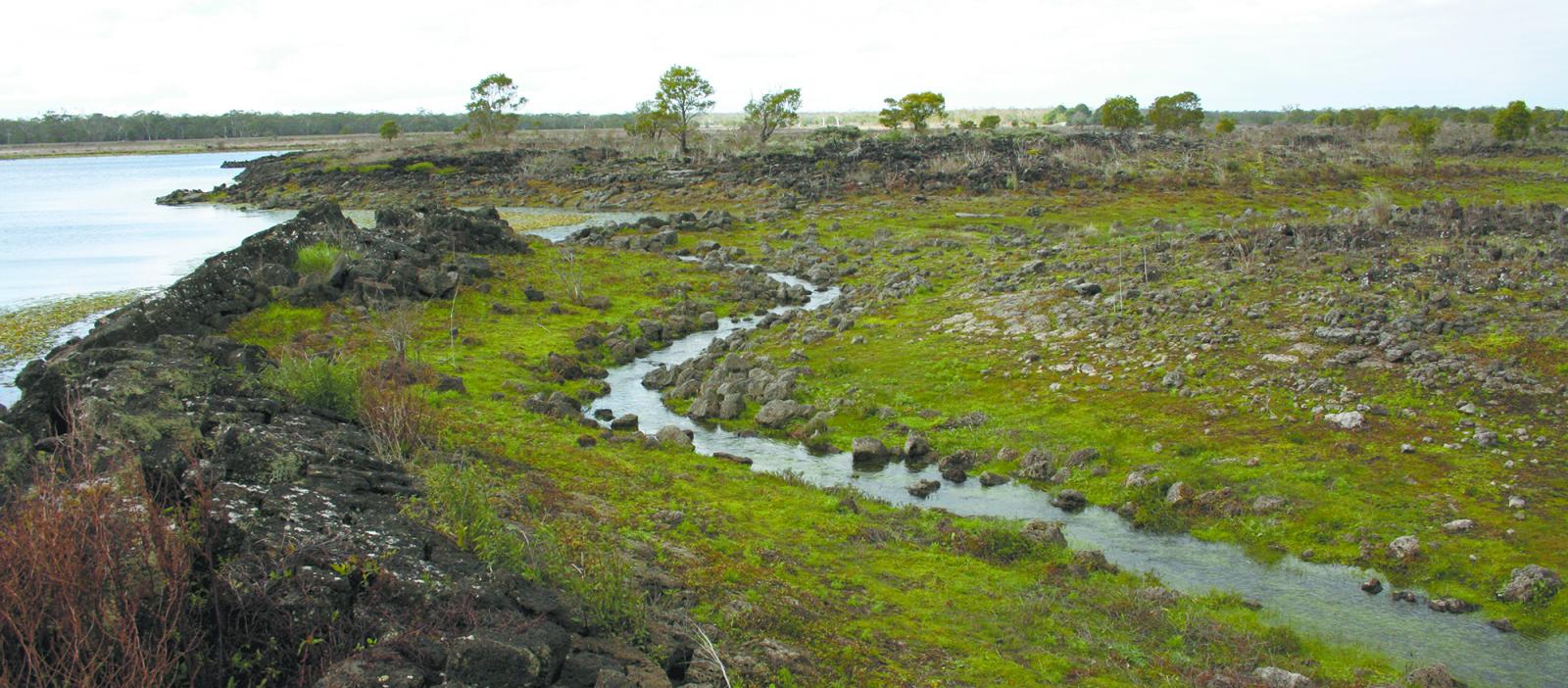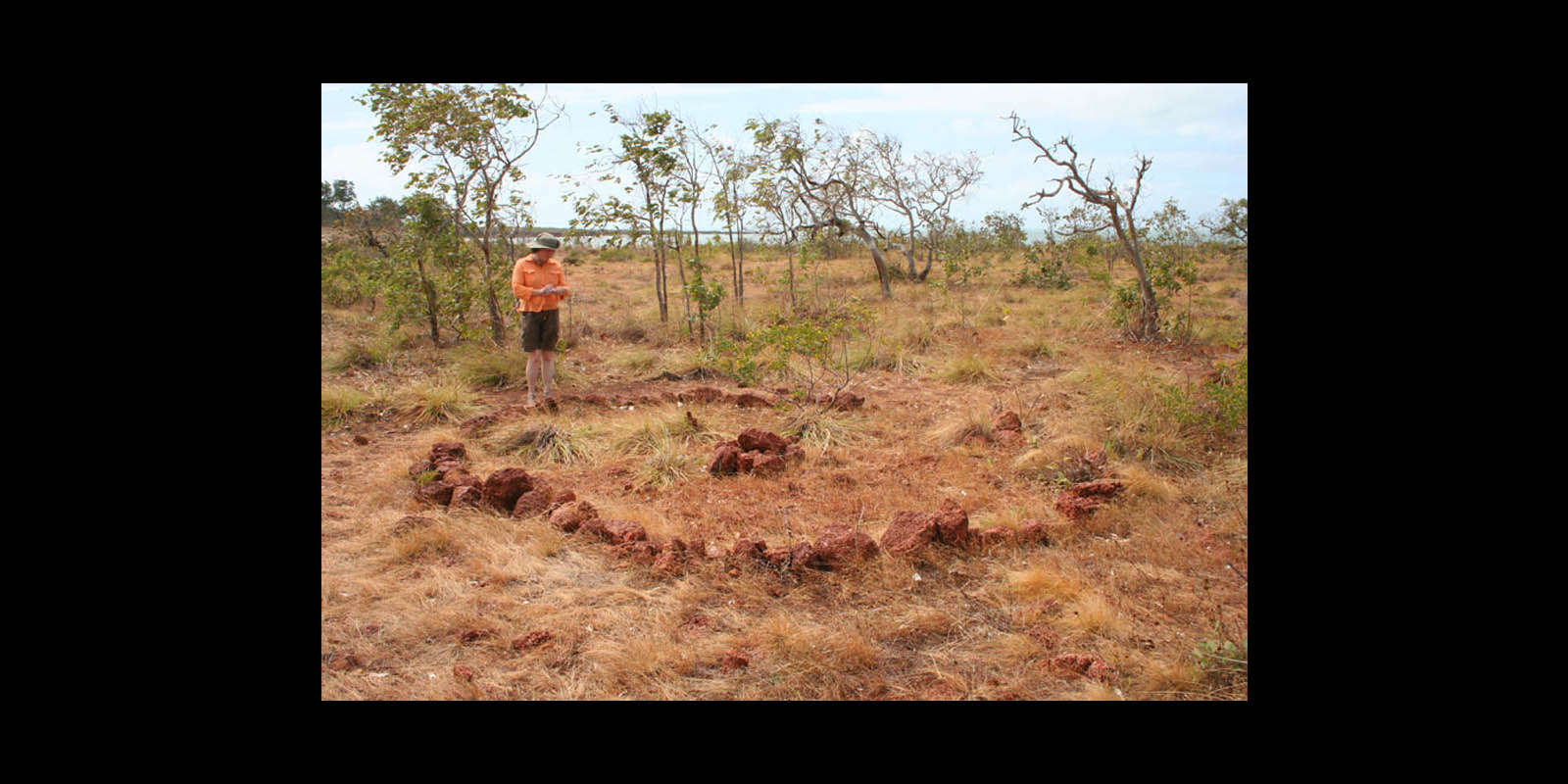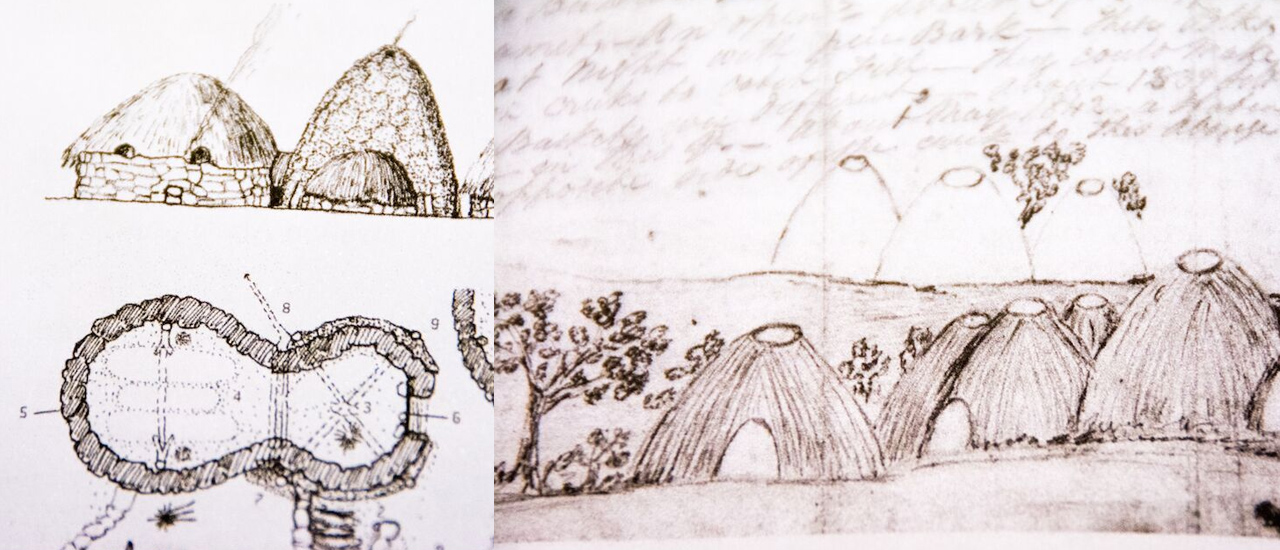Engineering is the area of science and technology focused on the design, construction and use of engines, machines and structures.
Aboriginal communities across Australia have achieved many amazing engineering feats, designing and building different structures such as watercraft, farming and agricultural systems, houses and more. This includeds permanent structures, many of which continue to be used and admired today.
This page looks at aquaculture, stone arrangements and houses.
Aquaculture
Aquaculture is the farming and breeding of water creatures including fish, eels, shellfish and plants for food and other human use. Aboriginal people are pioneers of aquaculture and there are examples across the Country of sophisticated fish trapping systems that are thousands of years old. Famous examples are Budj Bim on Gunditjmara Country and the Brewarrina Fish Traps on Ngemba Country in NSW.
Budj Bim – Gunditjmara Eel trap system
Budj Bim is a dormant volcano on Gunditjmara Country in South Western Victoria. Budj Bim erupted over 30,000 years ago and the lava flow created a system of channels that Gunditjmara people developed into weirs, dams and traps for fish and eels. This area around Budj Bim is one of the oldest aquaculture systems in the world and was recognised as a World Heritage Site in 2019.
Gunditjmara people managed the water flow from Lake Condah, creating dams and blockages to ensure the water flowed through the weirs and channels as they needed it. This aquaculture system supplied enough food to sustain their community all year-round and also allowed Gunditjmara people to trade with other Nations.
Read more about Budj Bim in the Deadly Story history timeline.
Queensland Traps and Weirs
There are at least 179 coastal and inland fish traps and weirs in Queensland however there are likely many more that have not been recorded. These traps were often made of stone and could be placed around the mangroves and the sea or at the mouth of creeks and rivers that lead into the ocean. Most of these traps and weirs were made by Aboriginal and Torres Strait Islander mob however some were made by non-Indigenous mob such as South Sea Islanders.
In northeast Queensland many of these traps are located around Hinchinbrook island and in central Queensland 18 fish traps have been recorded. Throughout the Torres Strait Islands fish traps were regularly used alongside other fishing practices. In the southern islands these traps, known as 'Sai', were very common and are said to have lined the shores of each island, however, these traps were less common in the western islands where they were called 'Graz'. Torres Strait Islander mob used songs to teach younger generations how to build and repair these traps.


Lake Condah. © Gunditj Mirring Traditional Owners
Stone Arrangements
Aboriginal stone arrangements are structures made by mob where stones ranging in size have been placed down to form specific shapes or patterns. Most of these sites seem to be related to ceremony and sacred traditions.
Many of these stone arrangements are registered cultural heritage sites under the Aboriginal Heritage Act (2006) and the penalty for damaging these sites is up to $300,000 for an individual or $1.6 million for a corporation.
Kooyang Stone Arrangement.
Kooyang Stone Arrangement is a 176 metre structure that sits on private land at Lake Bolac and is believed to have been created over 1500 years ago. Kooyang Stone Arrangement was a gathering place prior to invasion where different mobs would come together to honour and celebrate the life cycle of the eel.
In early April 2021 it was noticed that the arrangement had been partially damaged after the farmer who works on the land removed approximately 60 metres of the arrangement to make way for a boom spray.
Wurrwurrwuy Stone Arrangements
In an area in north-east Arnhem land, called Wurrwurrwuy by the Yolngu people, lay 74 stone arrangements. These arrangements are very unique to others found across the country as they depict the history of trading between the Yolngu people and the Macassans from Sulawesi in Indonesia.
The stone arrangements show Macassan praus (a double-hulled canoe), drying houses and trepang (sea cucumber) fireplaces among other things that relate to the trepang trade.
Trade between the Yolngu and Macassans is believed to have been an old tradition, possibly continuing for centuries before it was forced to stop in 1907 after the South Australian government (who had jurisdiction over the Northern Territory at the time) became aggressive when collecting customs duty.
They are believed to have been made towards the end of the 19th century by Yolngu Elders so that future generations could know of the rich history between their people and the Macassans.


Image source: Wikipedia, Wurrwurrwuy stone arrangements.
Housing
If you can’t imagine living through a Victorian winter without a house you aren’t alone! Although another myth about Aboriginal people is that we didn’t live in solid houses, this wasn’t always the case.
Houses and buildings differed across the country, depending on the materials available and the climate. For example, in wetter areas of the country, houses were waterproof to keep everyone warm and dry. We built houses made of stone, clay, wood and other materials and had different architectural styles and designs, such as buildings with beautiful domes roofs. In some areas houses were built with the floors below ground level to keep warm. Beautiful designs depicting stories and Lore were also featured on buildings and surrounding trees.
These houses were different sizes, with some fitting over 50 people, and for different purposes (for example some had ovens built in for cooking). Often houses and villages were built close to important food sources, including farms and fish trap systems.
On Gunditjmara country in Budj Bim the Gunditjmara people built stone houses and huts to assist with living permanently on the land and today there are over 200 registered and recorded stone houses.
Wurundjeri people had different kinds of shelters depending on the weather. In warm weather they would set up a few branches to protect themselves from the wind and in cold or wet weather they made comfortable houses called willams – these only took a little over an hour to make! Willams were built facing east or north-east to shelter from cold winds, there were two forked poles on either side and a horizontal pole across them. This was covered in wide pieces of stringy bark and bushes were tucked on either end with a rug inside and a small fire at the front.
Wiradjuri people built shelters using sticks, branches, leaves and bark. Some campsites were semi-permanent if the area had a large food and water supply while others were temporary with mob moving on once resources ran low. The main shelters Wiradjuri mob used were:
- Windbreak - used in the warmer months or while travelling, could be set up very quickly
- Lean-to - this was the most common shelter and was waterproof
- Mia-mia - this was a weather proof shelter used in the cold seasons and could fit a family of 4 or 5


A colonists' sketch of a Gunditjmara village, found in south western Victoria, drawn around 1840. Image Source: 'Dark Emu' by Bruce Pascoe.
Sources
Aquaculture
- The Guardian, Budj Bim Indigenous eel trap site added to world heritage list
- UNESCO, Budj Bim Cultural Landscape
- Visit Victoria, Budj Bim Cultural Landscape
- Michael J. Rowland and Sean Ulm, Indigenous Fish Traps and Weirs of Queensland
Stone Arrangements
- Josh Hrala, This Australian rock formation could be older than Stonehenge
- Department of Agriculture, Water and the Environment, National Heritage Places - Wurrwurrwuy stone arrangements
- ABC News, Aboriginal group 'traumatised' by alleged partial destruction of ancient Lake Bolac eel-shaped stone arrangement
- Aboriginal Victoria, ABORIGINAL STONE ARRANGEMENTS
Housing
- Nillumbik Reconciliation Group, Wurundjeri Culture Resource Kit
- Bruce Pascoe 2014, Dark emu, black seeds: Agriculture or accident?, Magabala Books Aboriginal Corporation, Broome
- Bruce Pascoe 2019, Young dark emu: A truer history, Magabala Books Aboriginal Corporation, Broome
